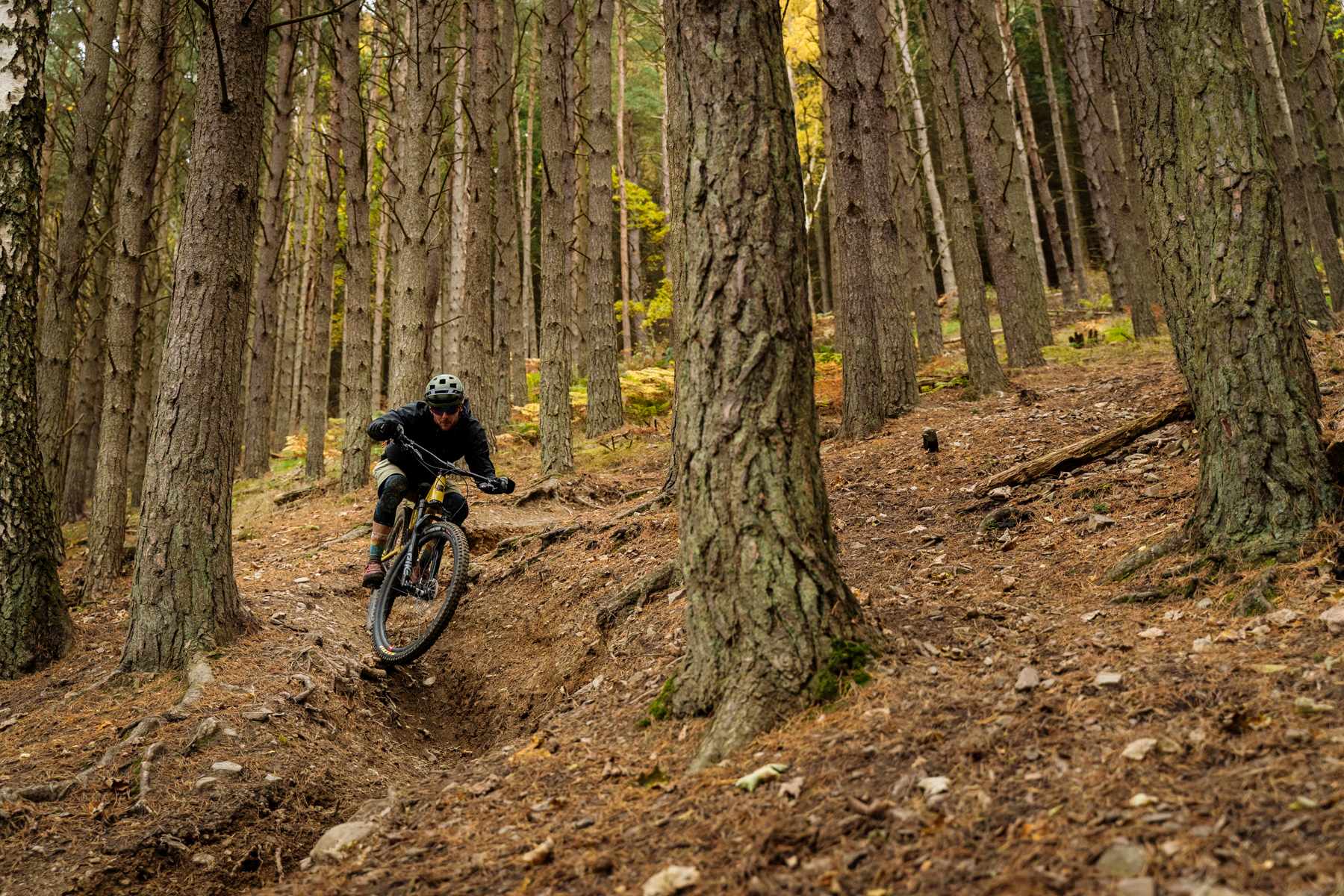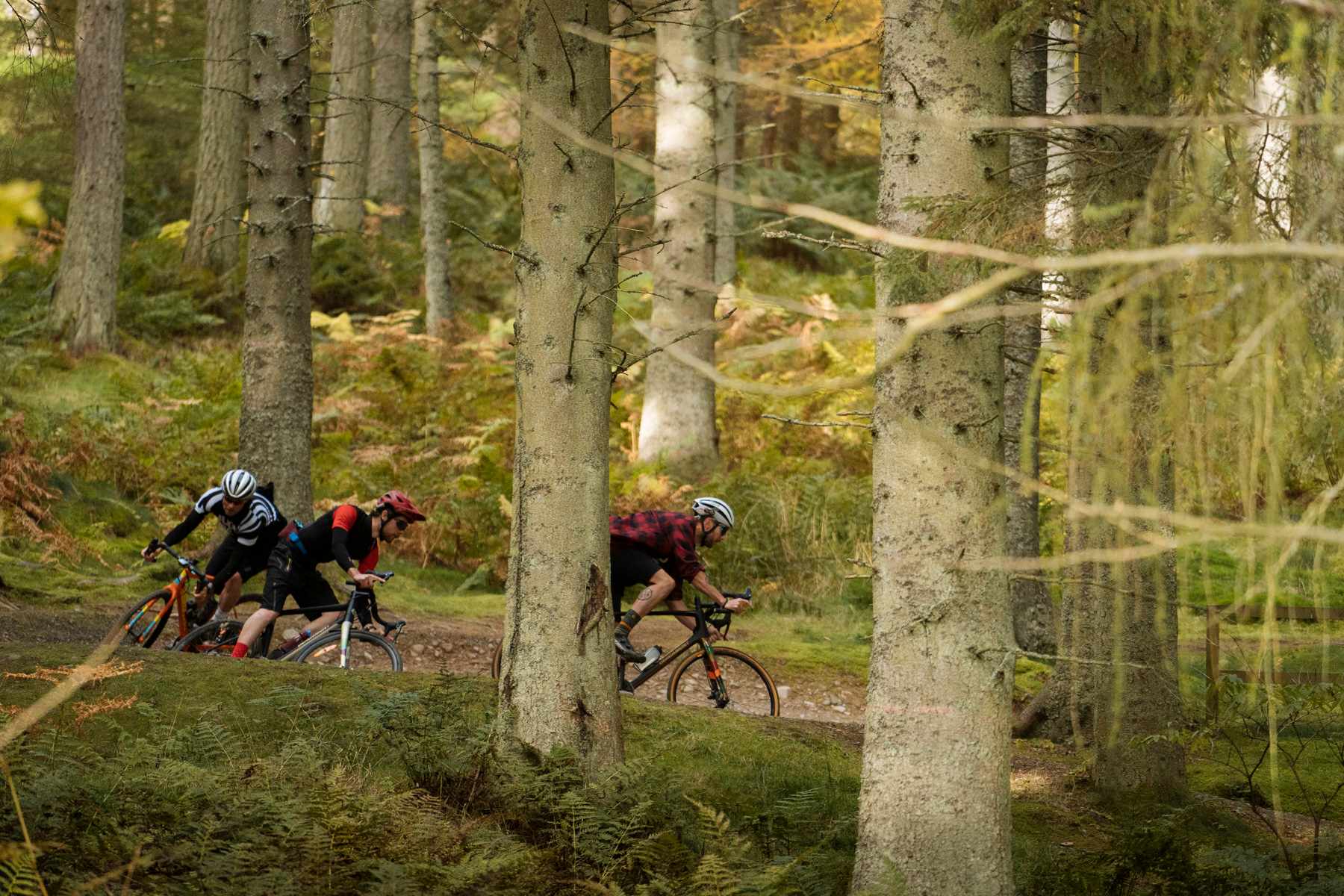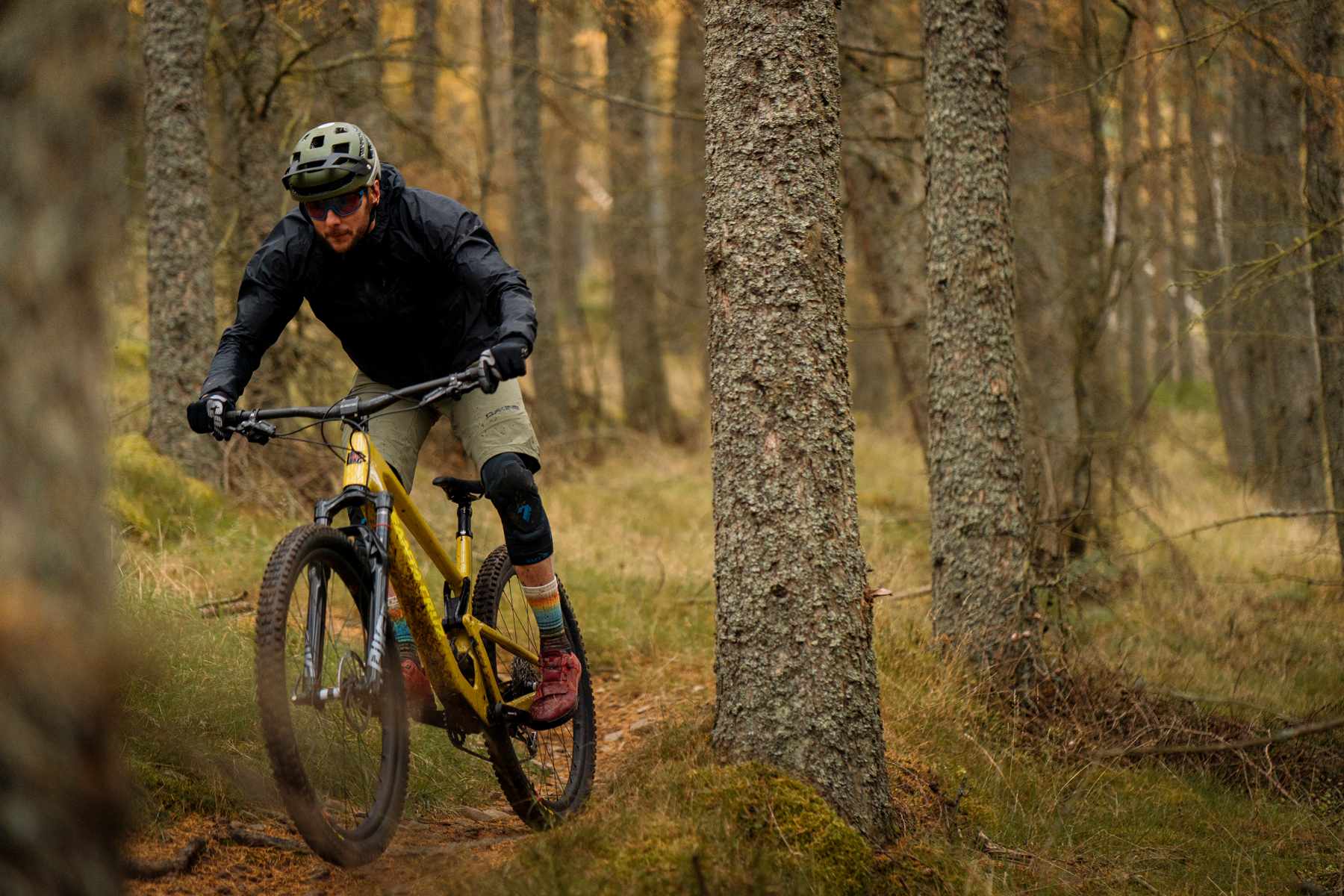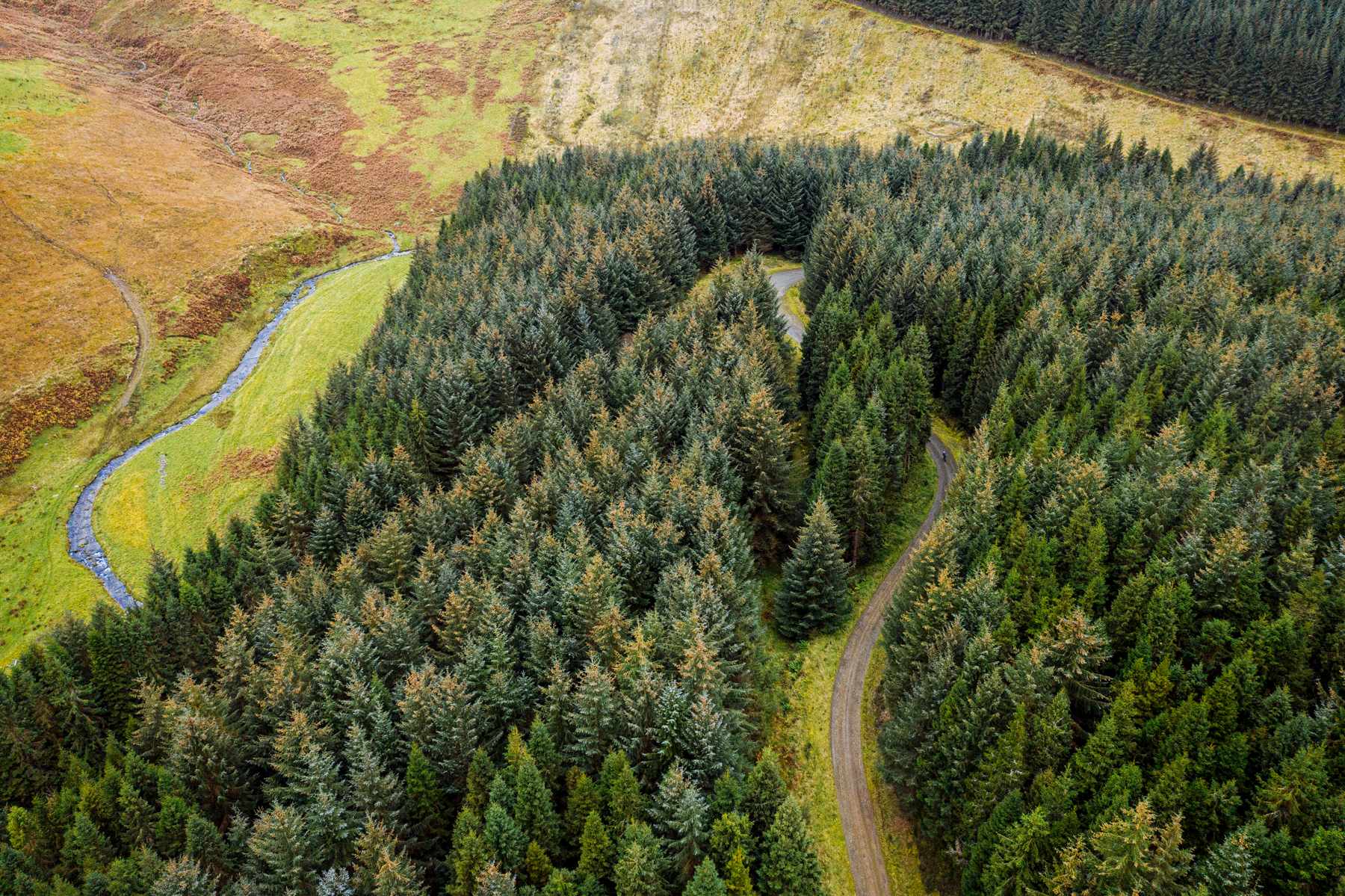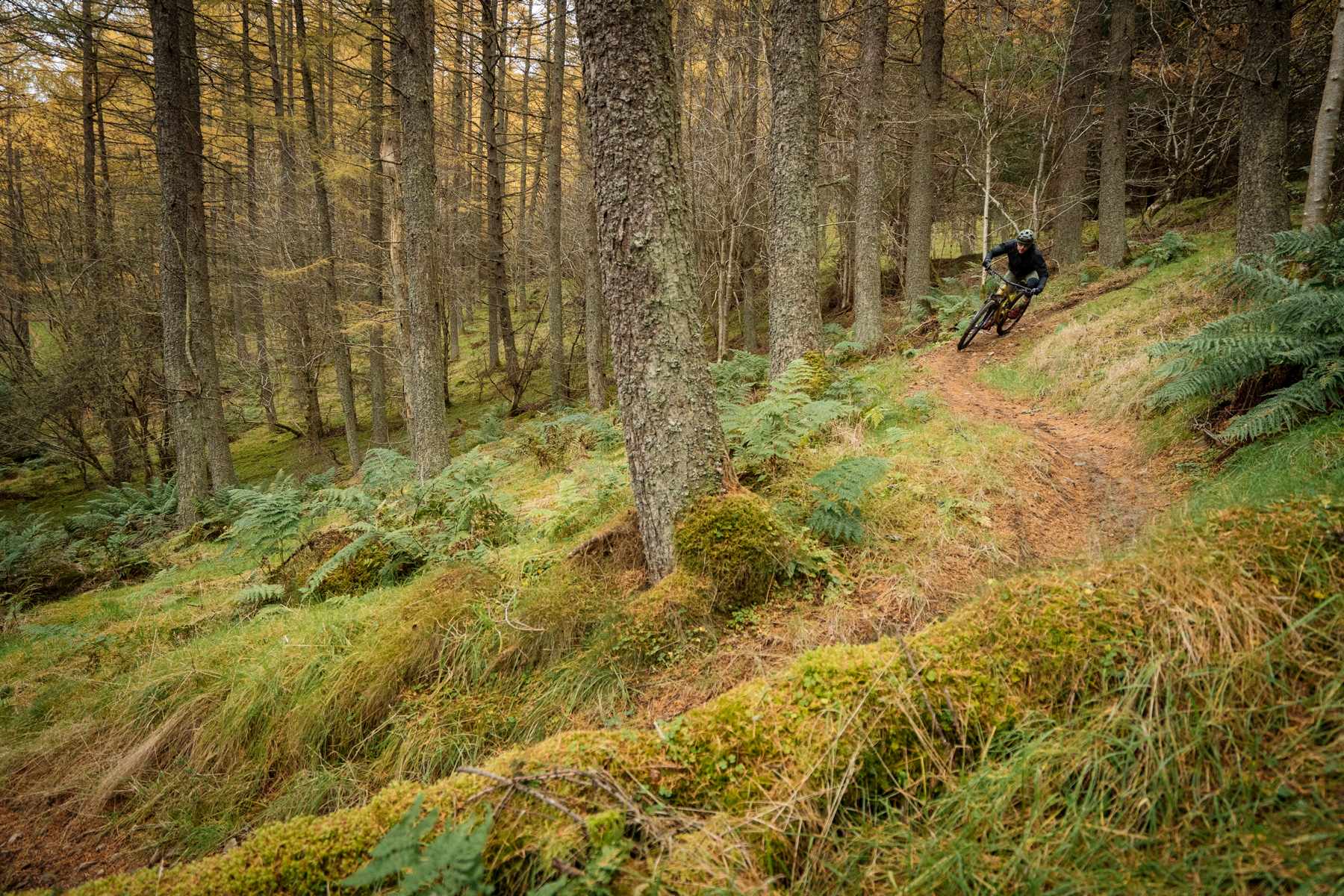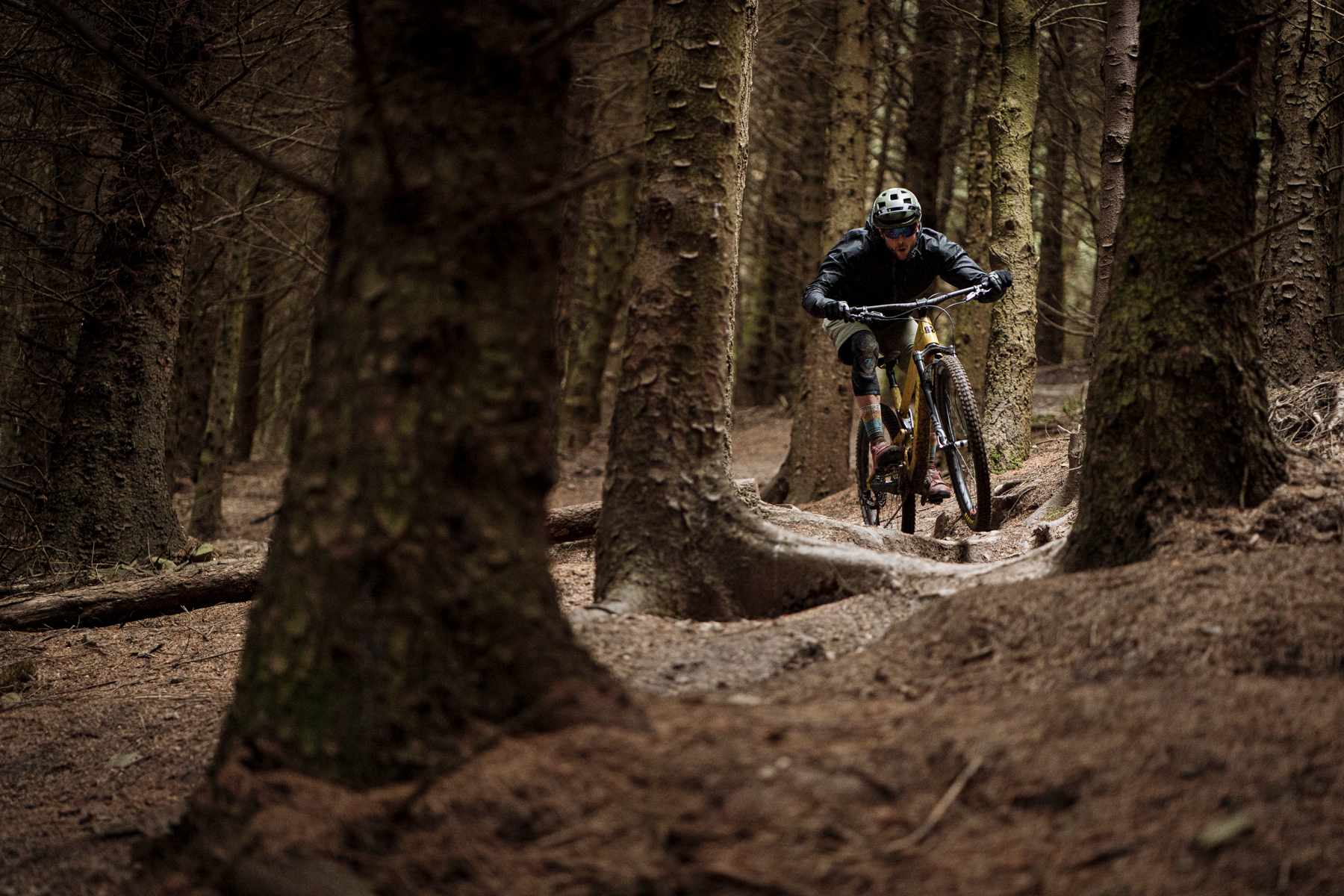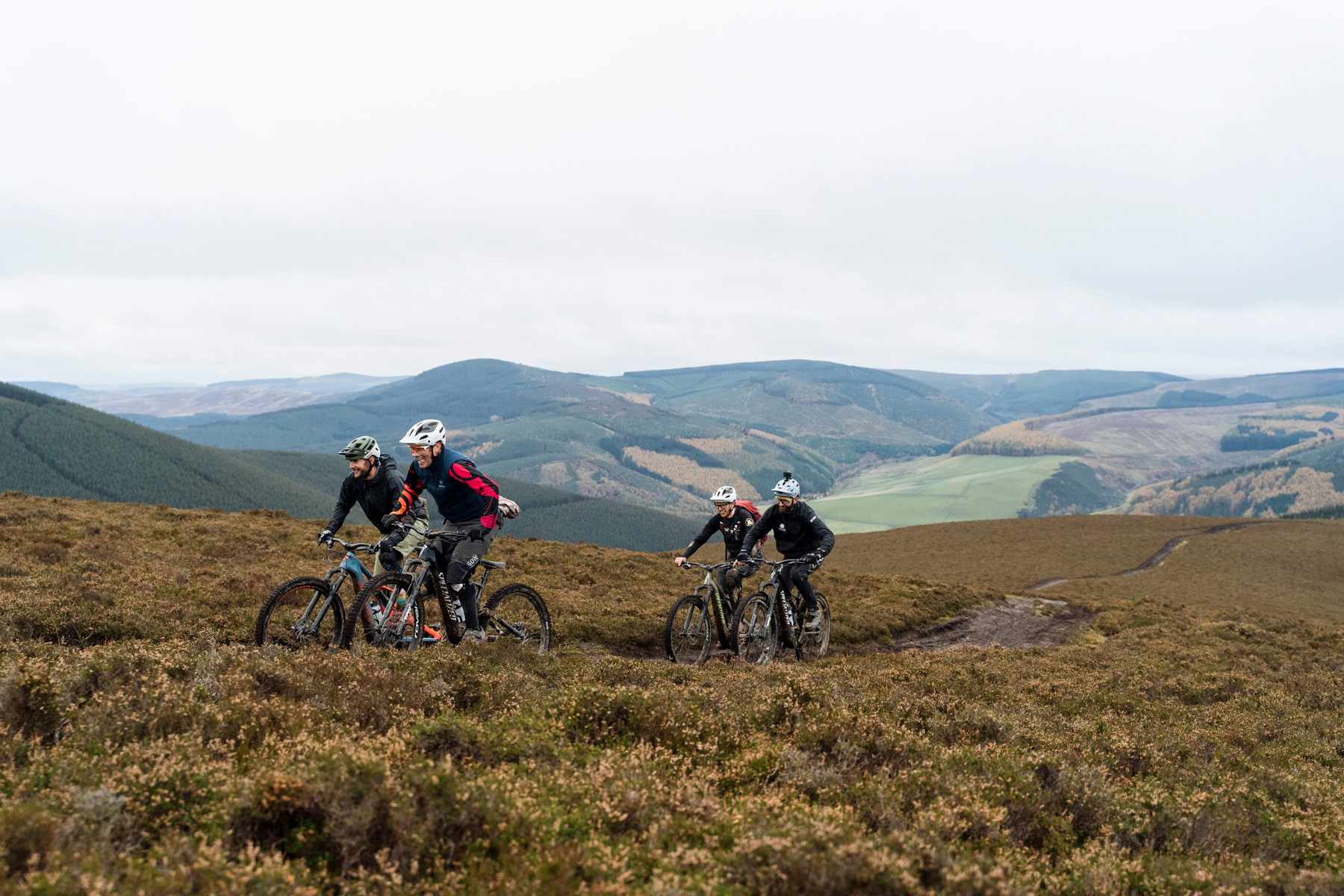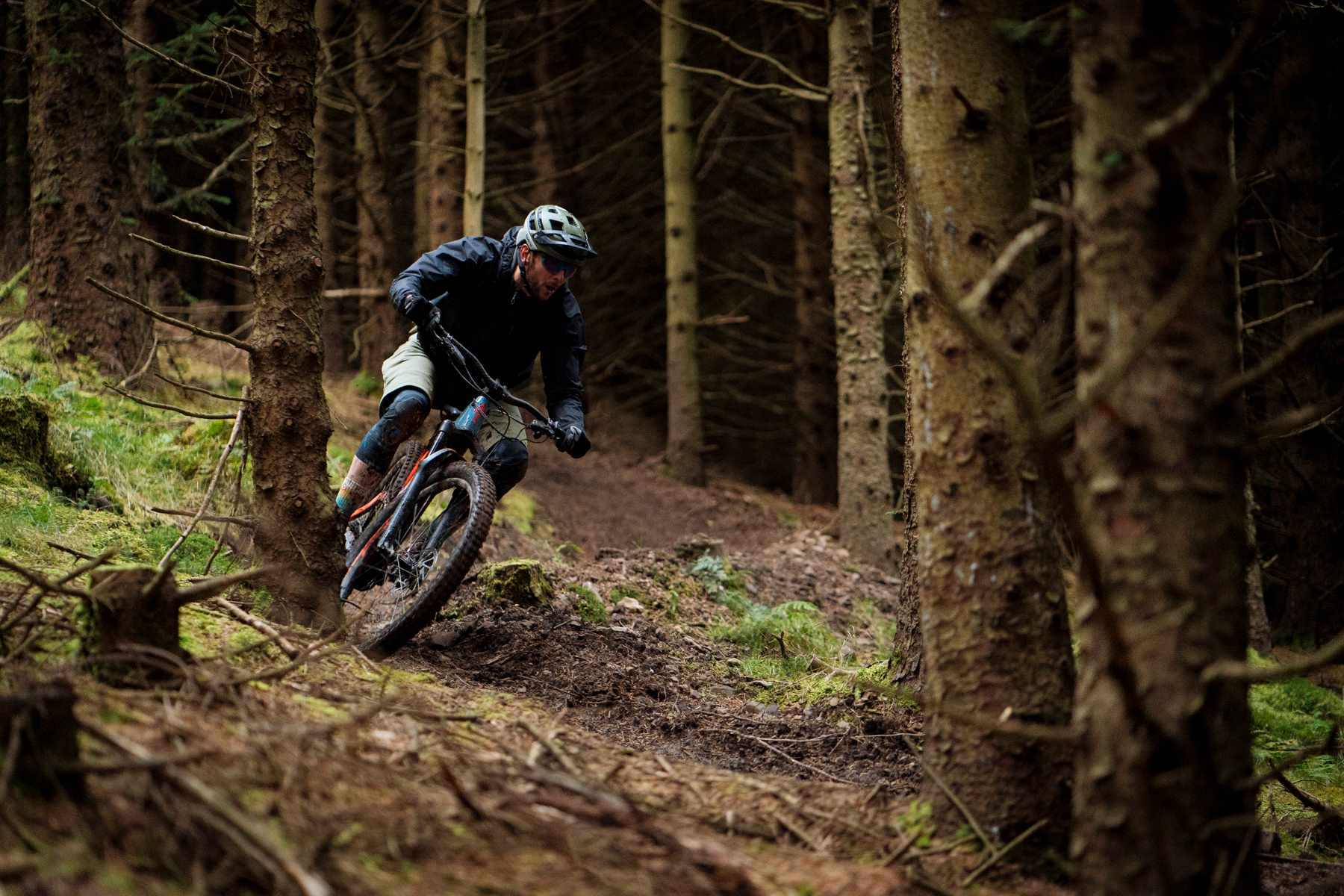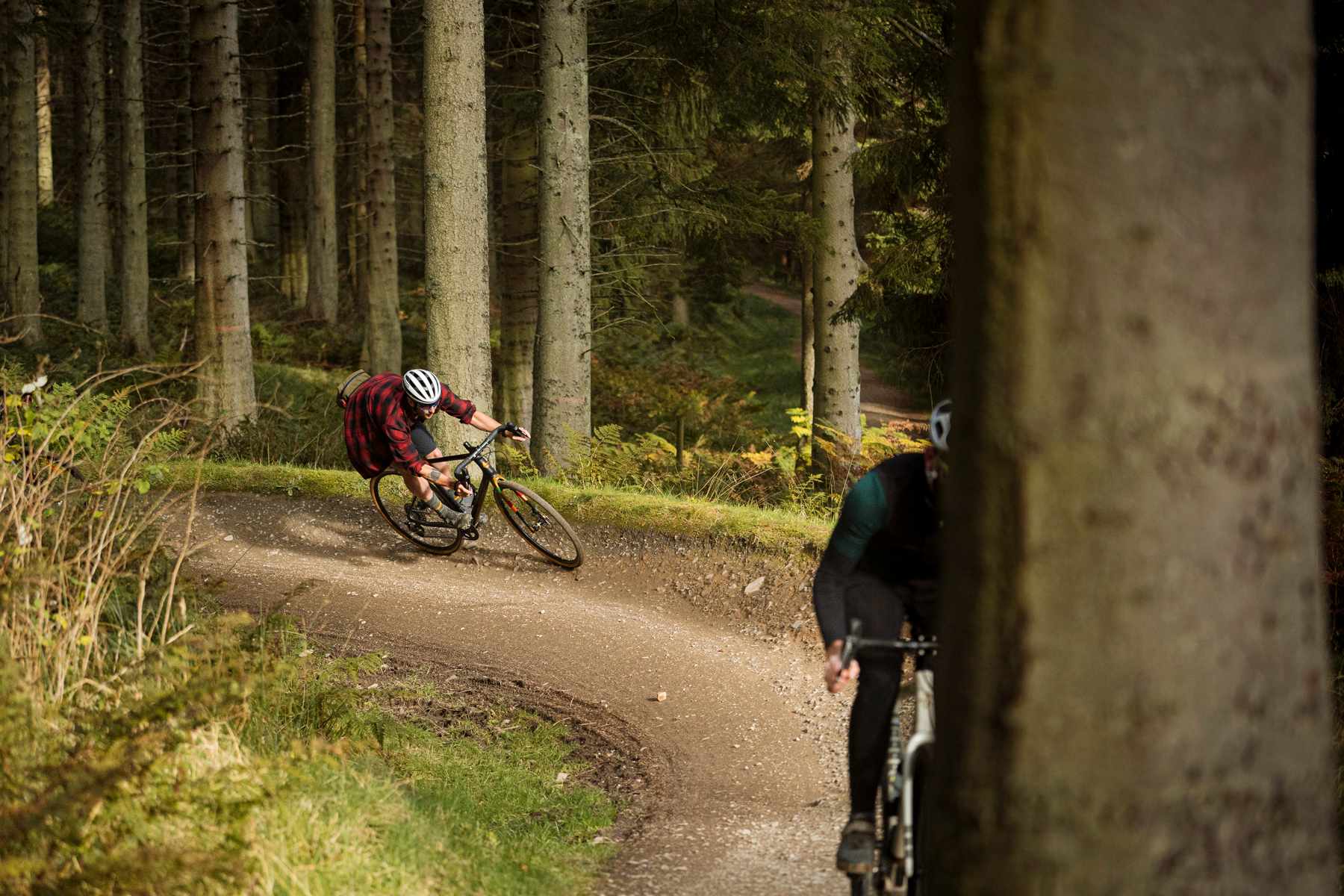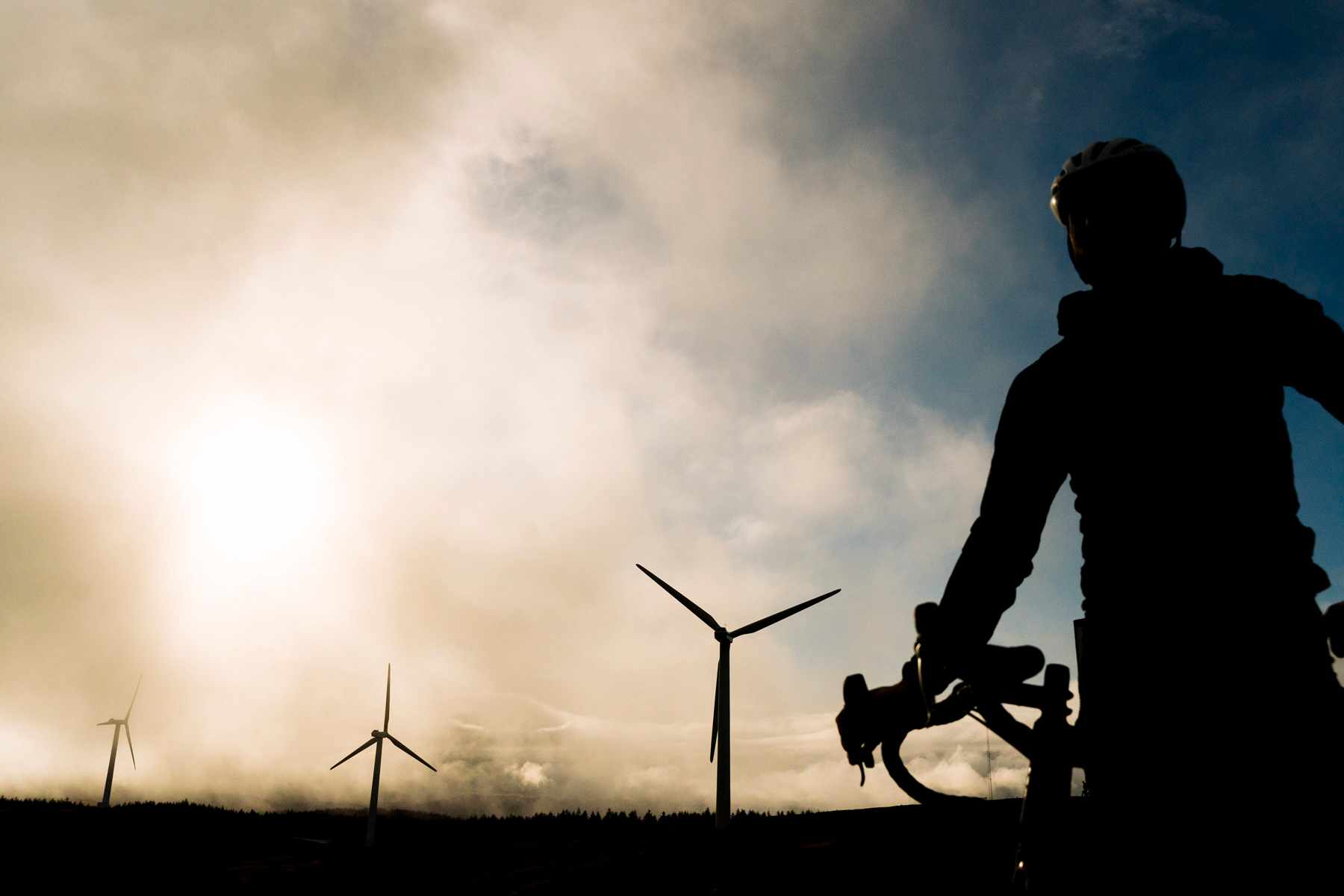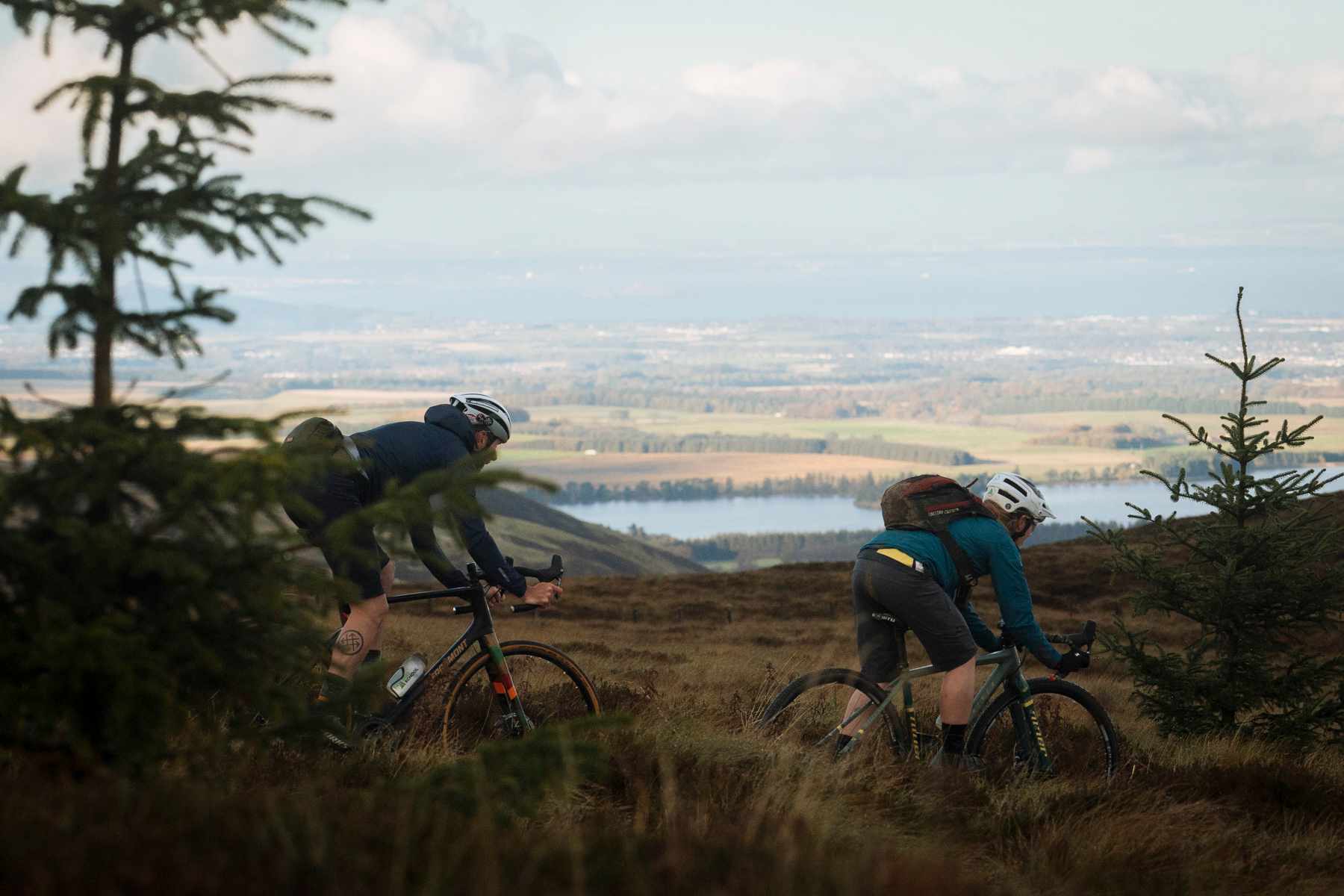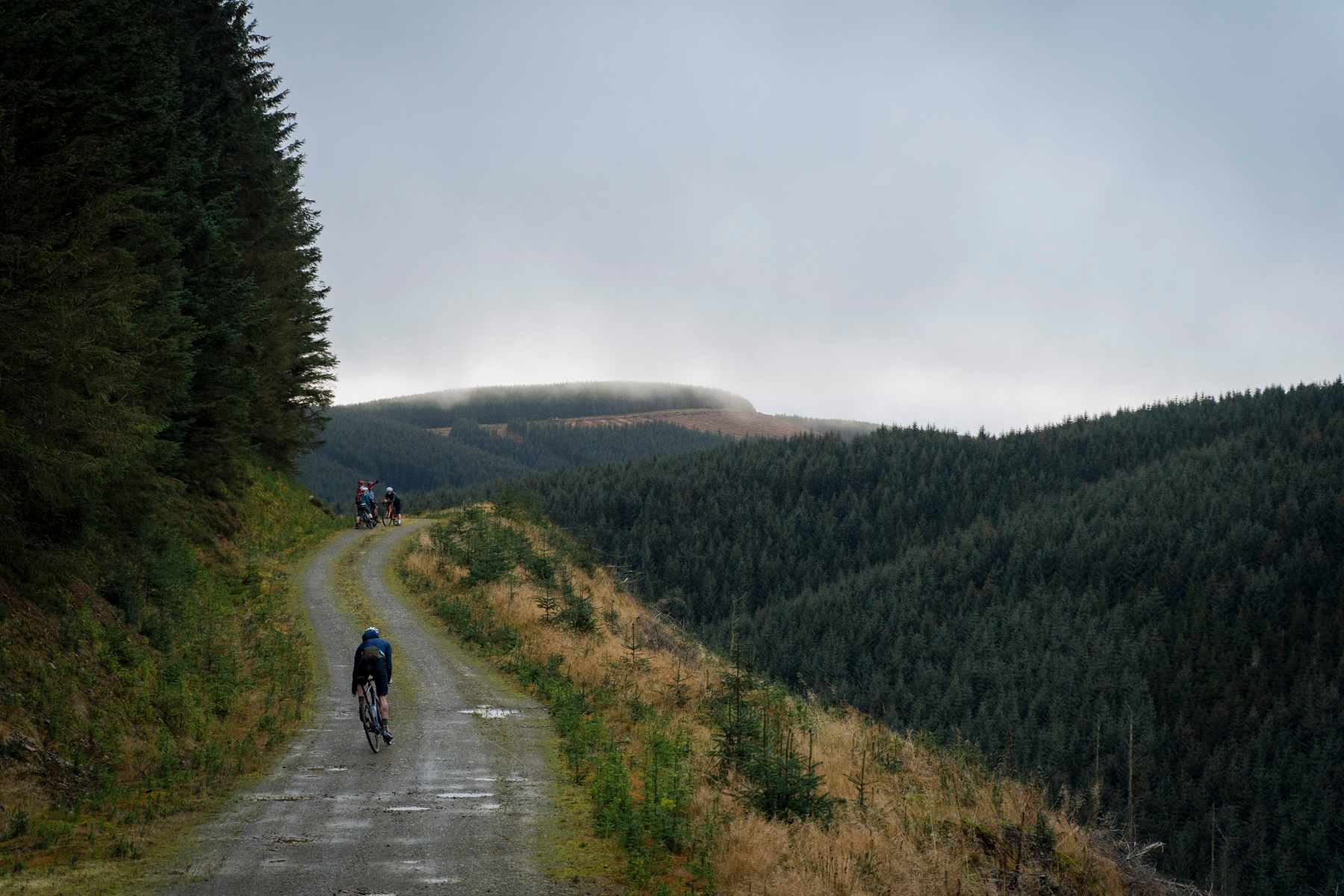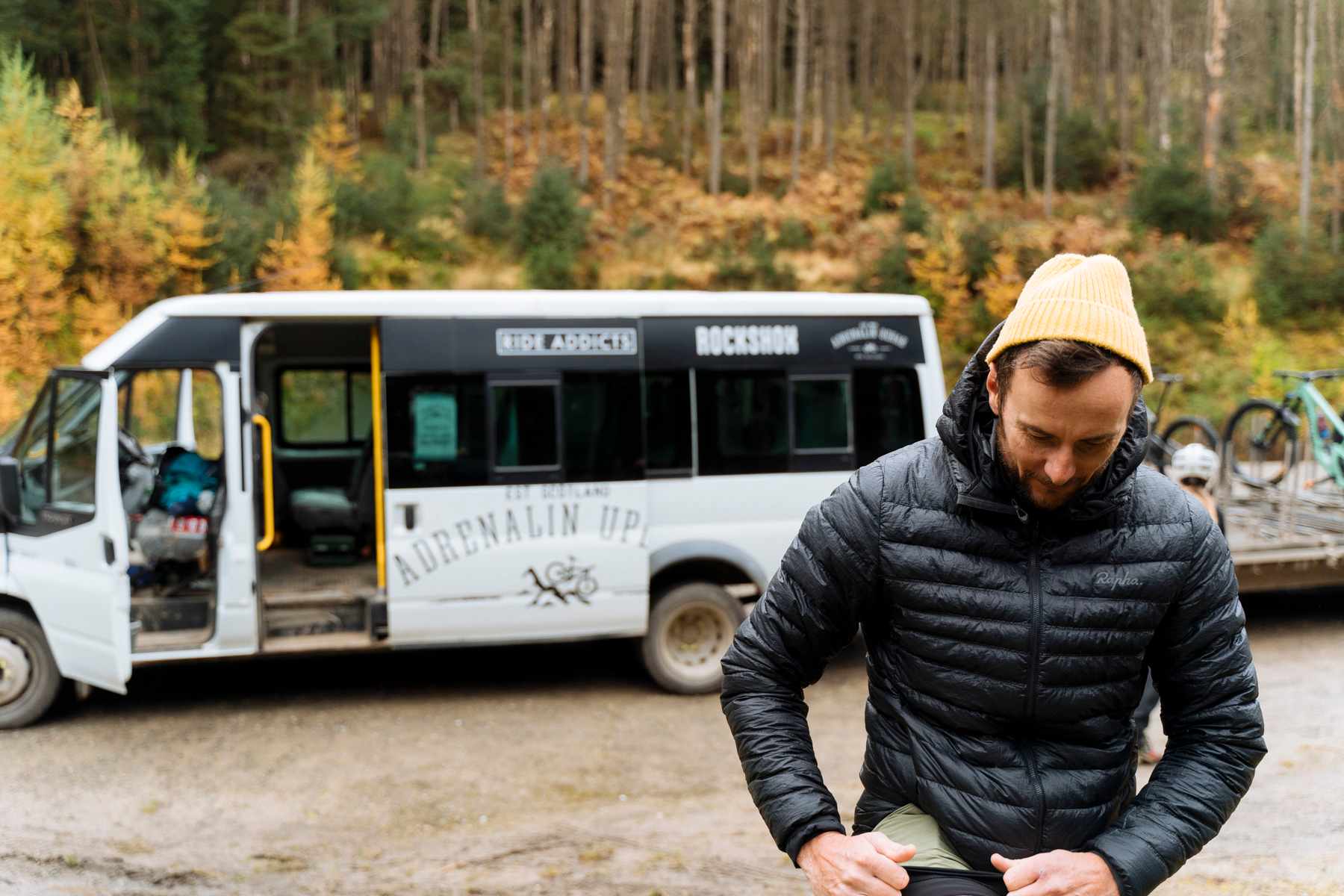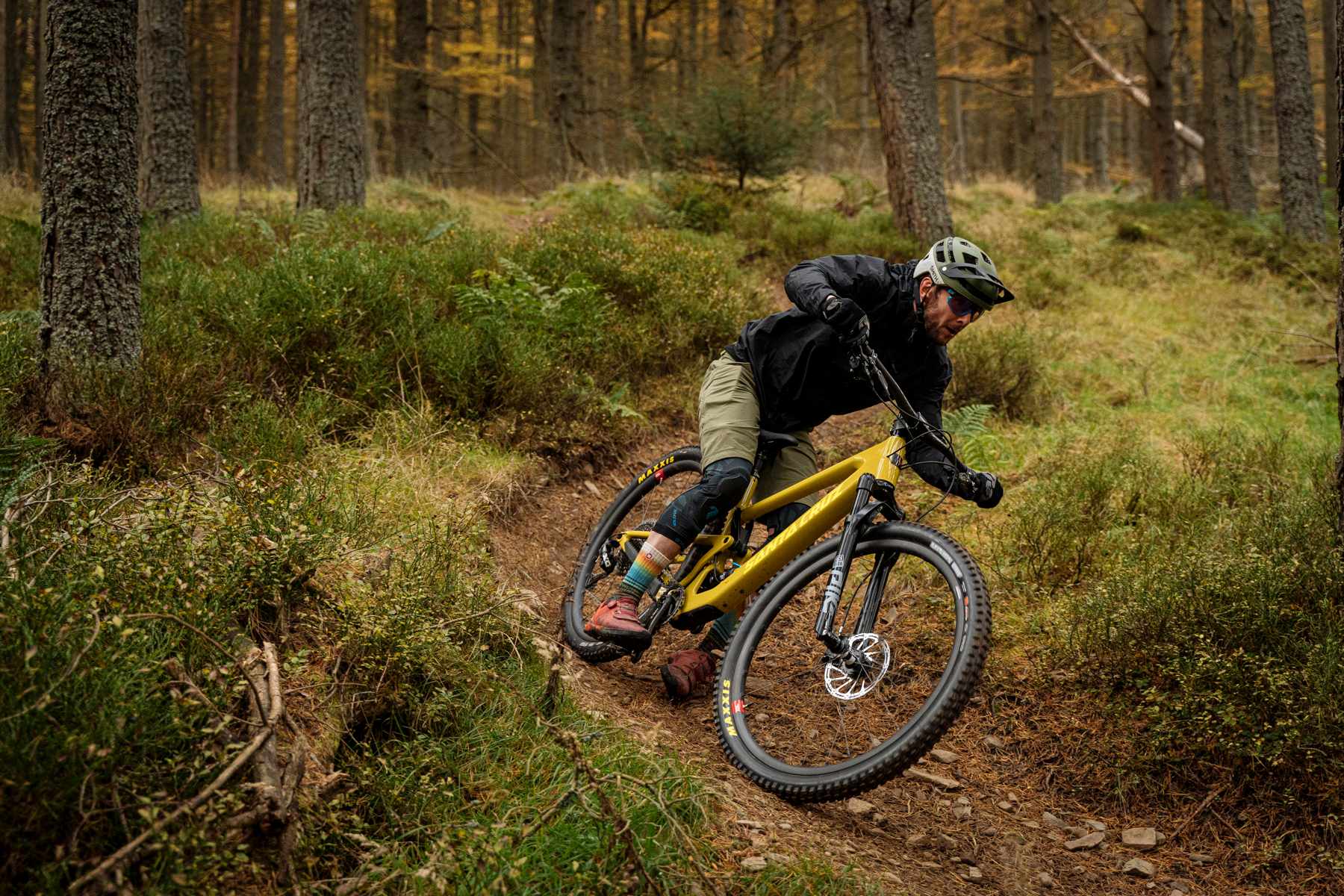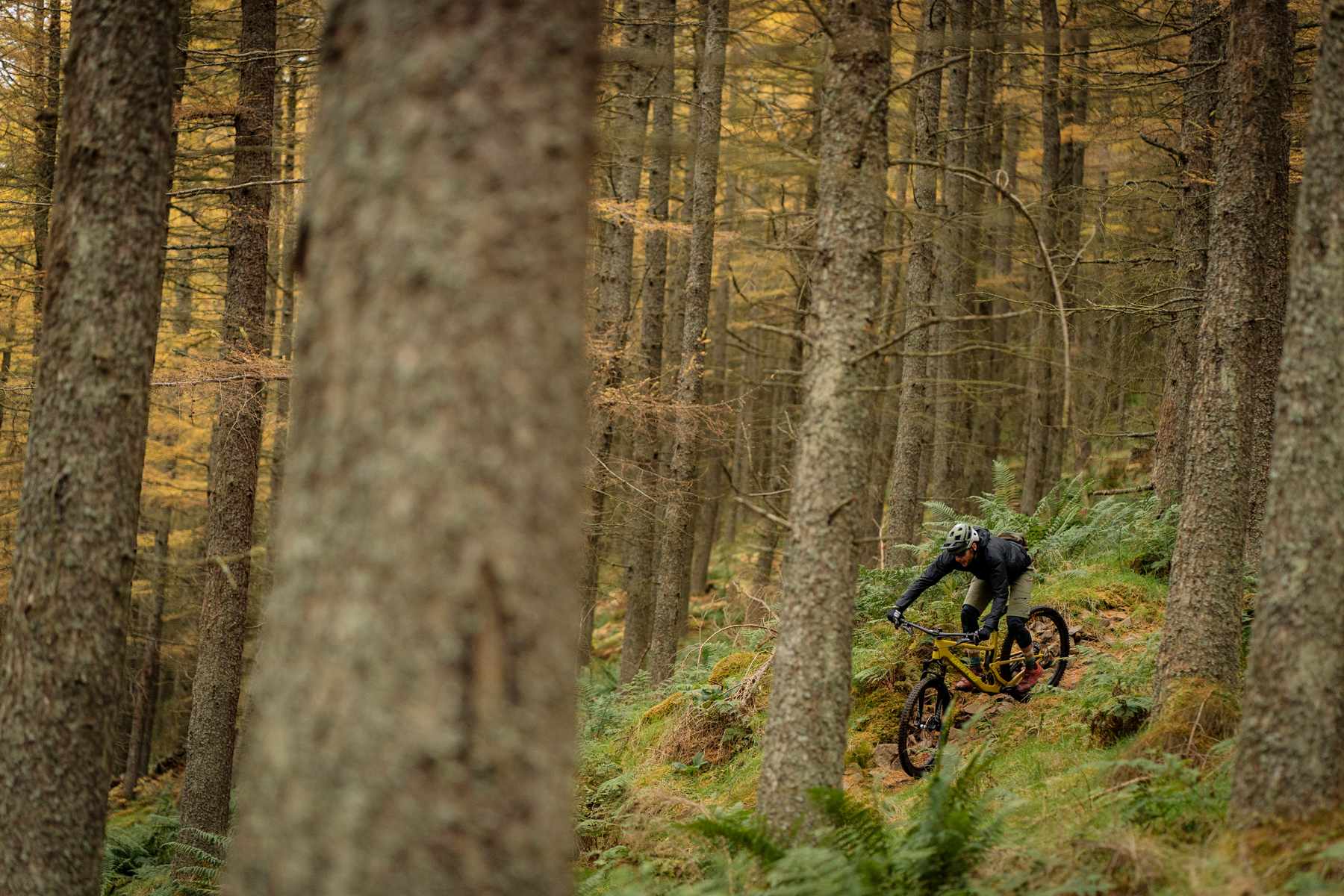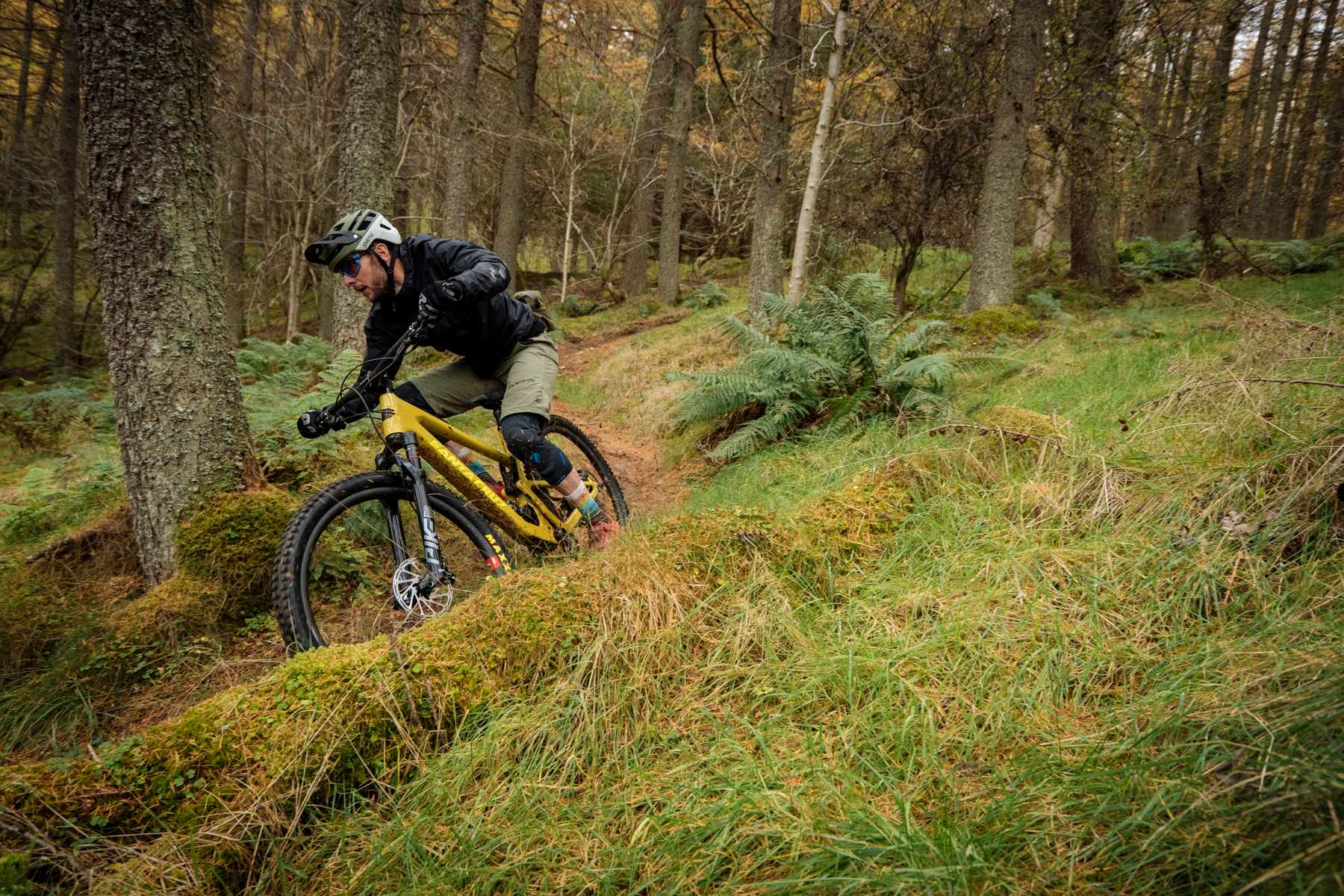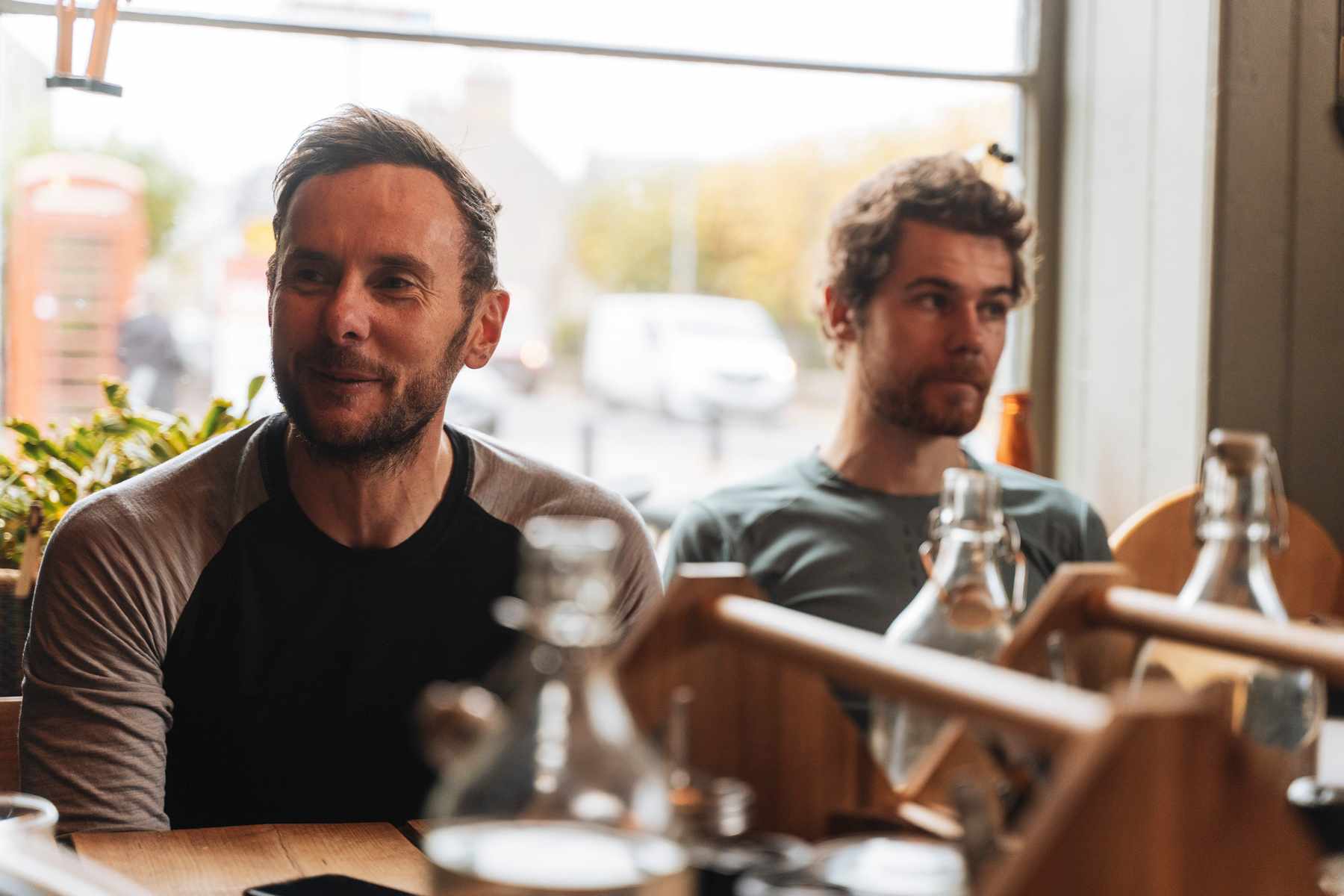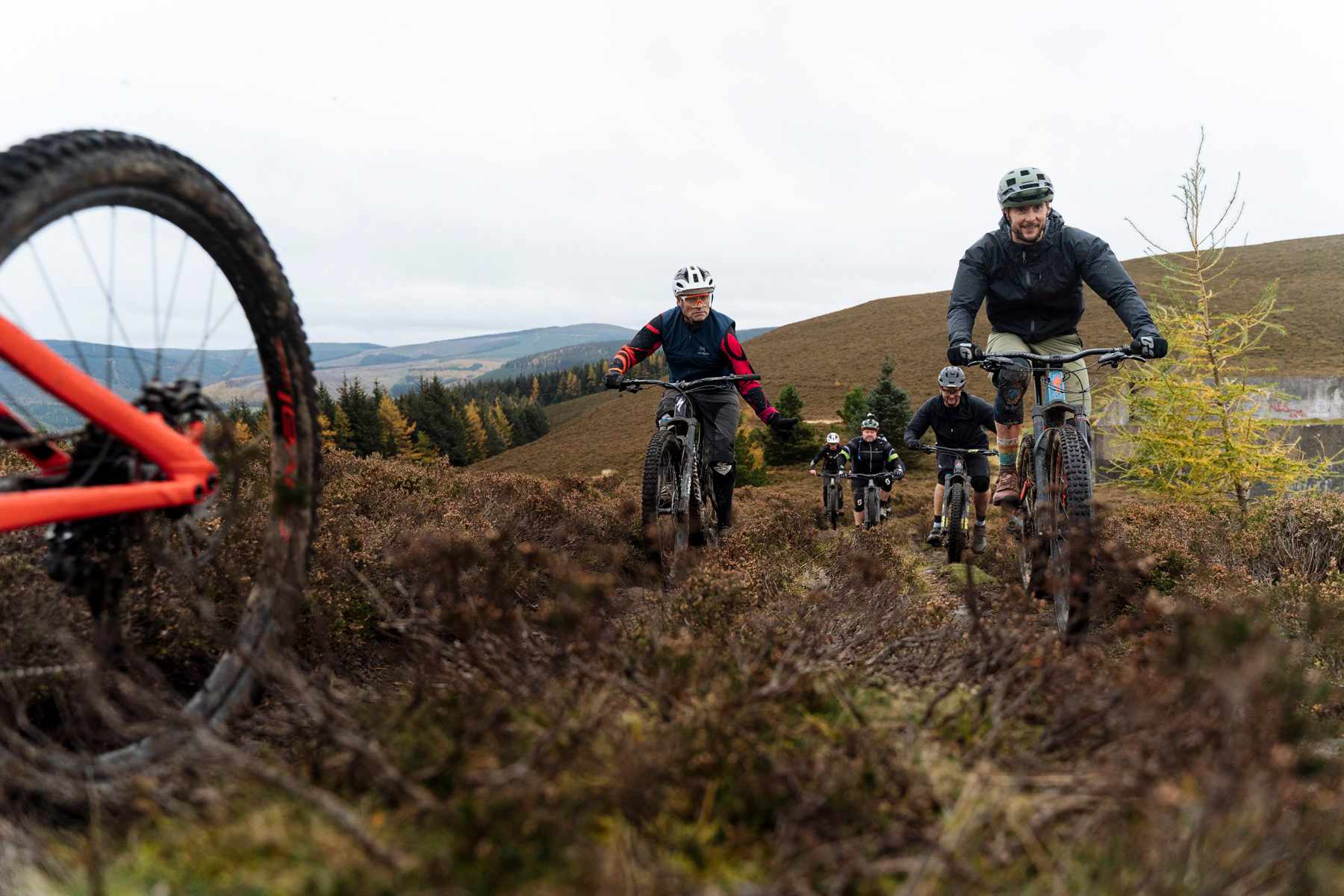Tom Hill looks at why hiring a local guide, despite GPS and the internet – even in our over-explored island – is still money well spent.
Words Tom Hill Photography Duncan Philpott
Our group paused at the high point of the ride. Huge wind turbines sprouted from the heather like giant white tulips. A bitter autumnal wind pushed and tore at rain clouds, granting us rays of golden light from the low sun then closing the curtains as an icy squall raced through. Despite the very obvious human impact on the landscape, it felt as though we were in the middle of nowhere; we hadn’t seen a single person since leaving the marked trails of Glentress an hour or so ago. We discovered a seemingly endless network of pristine forest roads, perfect for gravel exploration, granting views to Edinburgh in the north and linking into drovers’ roads that existed long before the commercial planting now below us.
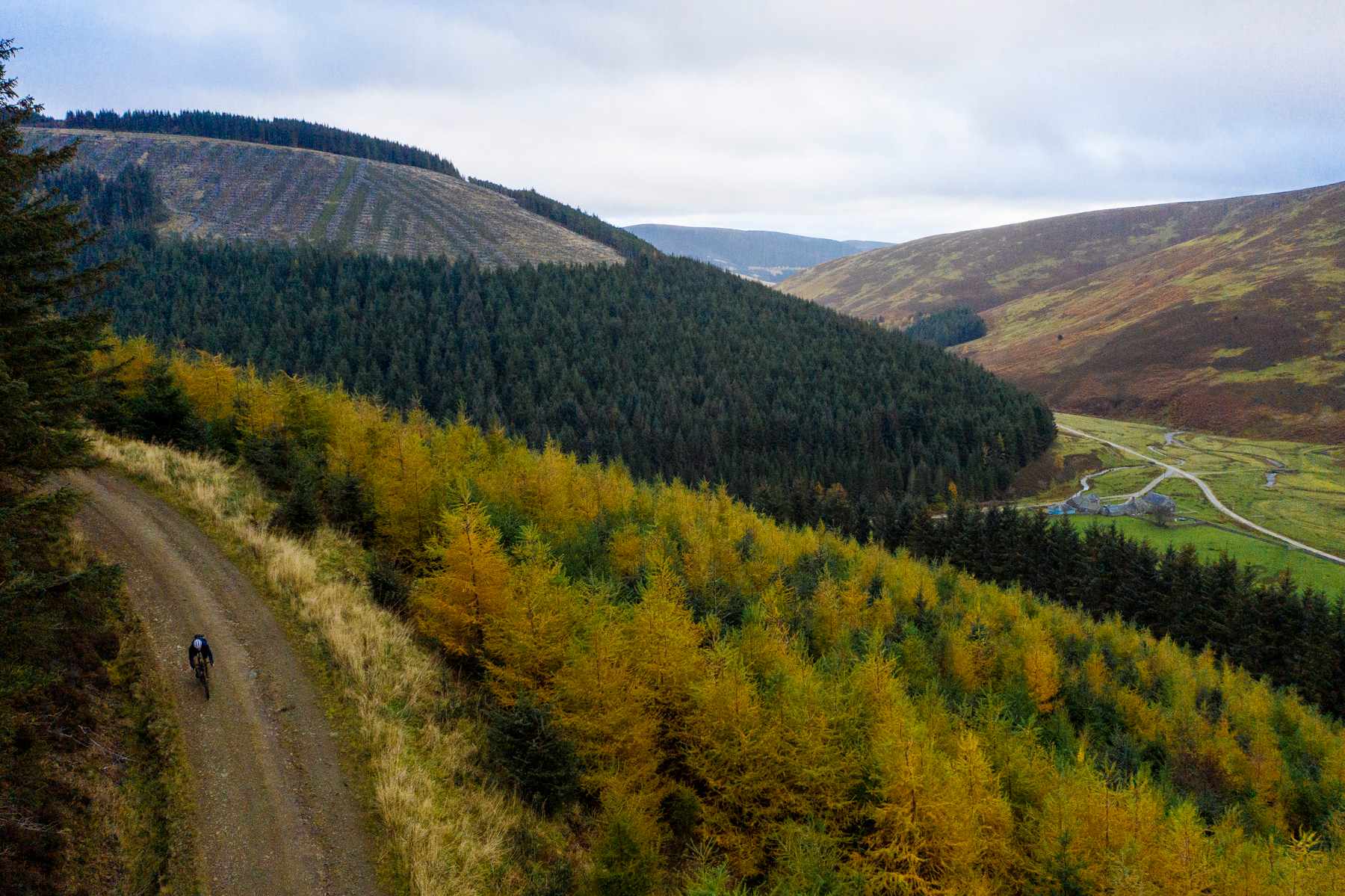
I was in the Tweed Valley for a few days, invited by the newly established, and ‘does what it says on the tin’ monikered Tweed Valley Guides to be shown the best of what the area has to offer – whether that be big days on a mountain or gravel bike, or hitting some of the best enduro-style trails in the country.
Latest Singletrack Merch
Buying and wearing our sustainable merch is another great way to support Singletrack
Beyond the excuse of back-to-back days of riding after a few too many weeks at a desk, I was intrigued to discover a little more about not just Tweed Valley Guides, but UK guiding in general. For those of us with the time and inclination, there is little mystery to finding the tracks I started this story with. They are clearly marked on the Ordnance Survey map, and it’s easy enough to link them into a circular loop. GPS devices provide a comfort blanket to the navigationally challenged. On the mountain bike side, the unofficial built trails that the valley is increasingly becoming known for are meticulously documented in apps like Trailforks and Strava. At first glance, it’s not necessarily an easy job to explain why you should pay someone to show you around when technology will do half the job for you.
So, why pay for a guide?
As we climbed away from the trail centre, it was a question that I asked Matt, one of the guides employed by the service. Before he got a chance to answer, he and fellow guide Janey had paused the group to explain the next descent had a sting in its tail – the smooth, sandy surface turning into jumbled aggregate just when you don’t need it. Caution heeded, we set off gathering pace, but feathering the brakes. As it turned out, despite the warning, an ugly line choice led to a familiar ‘clunk, hiss, arse!’. Before I’d dropped my rear wheel out of the frame, Matt was pre-inflating a spare tube for me. Well, that’s one benefit of being guided, I guess.
Back rolling and Chris Ball (Mr EWS, founder of Tweed Valley Guides and local resident) joined Matt and me. His enthusiasm for local riding is nothing short of gushing. A man who has probably ridden more of the best trails in the world than most is evangelical about what he can access on the doorstep. Matt is equally passionate, and they have a natural enthusiasm when it comes to sharing this with others.
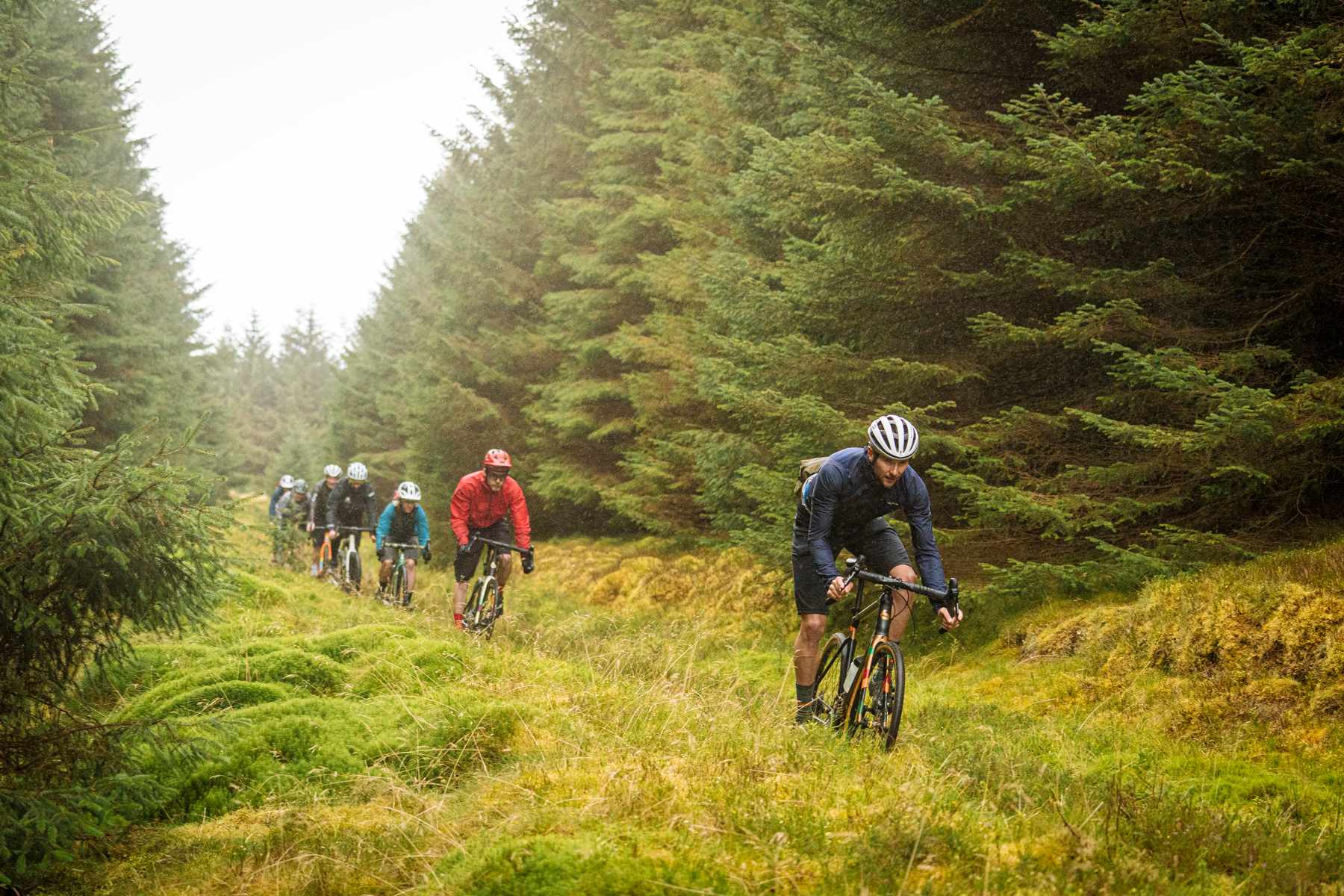
Tweed Valley Guides was born out of Dirt School – set up to offer skills and technique tuition in the surrounds of the same area. It’s interesting to think that our mindset has shifted over the years. Many of us have been convinced to pay for help with how to ride. Fewer seem willing to pay for guidance on where to ride. It was a question that the Dirt School coaches were frequently asked though: where’s best to ride here? A guiding service was a logical extension.
I moved to a new area this year. Not far, but far enough to need to discover a new network of trails for my day-to-day riding. I’ve used every tool at my disposal, found some gems, slogged through deep mud, making note to return in spring and had to turn around after accidentally routing myself into a complete dead end. I’ve (mostly) enjoyed the process, but time has been on my side. Some unfortunate friends have had the misfortune to join me on these exploratory forays, the weight of their enjoyment sitting heavily on my shoulders. Fortunately most know what to expect from a Tom-ride now. I’d have been frustrated with a fair chunk of this ‘wasted’ time had I paid for accommodation and travel and I knew there was great riding lurking somewhere between the folds of the map. It makes complete sense to me that it’s worth paying someone to show you the best bits if you visit a new area and are pushed for time. Even more so if you are part of a group and the responsibility always falls on the same person to do the planning.

Hidden bronze
It was with a whisky-induced fuzzy head that we climbed into the Adrenalin Uplift van the following day. Based at the bottom of Innerleithen trail centre – part of the original 7stanes network and long home to downhill trails before enduro existed – there are now dozens of unofficial tracks cutting through the woods. You can climb via the trail centre route, or on the fire road, but an uplift maximises the fun/time quotient and gives you longer to shake off the hangover.

As we bounce up the main uplift track, Janey tells me that a lot of riders will ask to ride the tracks used when the EWS visited in 2014 and the steepest stuff the nearby Golfie has to offer. The reality is that after riding one of the less full-on trails as a warm-up, the group is often not so keen on taking on the most eye-wateringly vertiginous, technical trails. A good guide will be flexible and tweak the day based on the aims, abilities and fitness of the riders. Fortunately there is plenty of flow to be found if you know where to look, especially on this side of the valley.
We start our day on Angry Sheep – one of the easier options on this hillside – a trail that Janey knows intimately, as she played a part in building it. The top section is a joyful-looking snake of perfect arcs linking their way down. Tweed Valley Guide’s strapline is “Discover the Hidden Gold”. This is more like hidden bronze as rust-coloured pine needles frame the loamy line. Despite what has felt like incessant rain for the weeks preceding, the trail was in primo condition. We were a noisy train making our way down, whooping as we tried to keep up with Janey. There were no complaints when we pushed back up for ‘one more photo’. While the trail isn’t particularly steep or technical, it is probably a little more challenging than an average trail centre run. It’s easy to understand how riders could get caught out by the colour-coded, but inconsistent Trailforks grading for example.
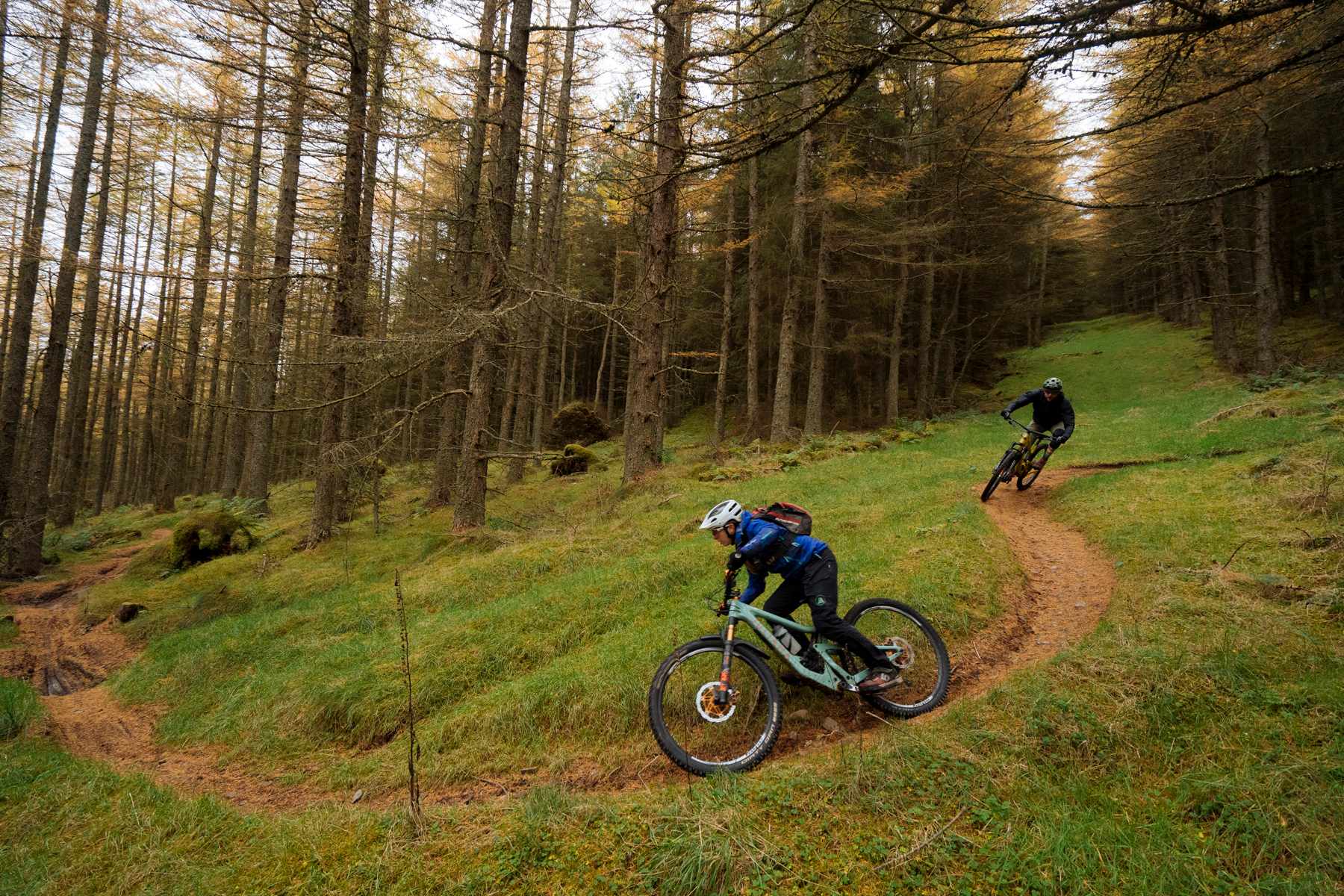
Back up, and we climb further, using the original red trail to gain a little more height before descending once more, this time on some more challenging trails, and recently built lines. While they are harder to ride well, they are universally well built – impressive when you think that the vast majority of them were built by locals without authorisation, but toleration from the Forestry Commission.
Part of the bigger picture
There’s a complex relationship in the Tweed Valley. There are now over 100km of these unofficial built trails, stretching from west of Peebles all the way to Selkirk. The quality of the riding has attracted riders and races from far beyond the valley. This has generally had a positive impact – the trails have bedded in and become well established, and there is a huge total benefit to the local economy. Whether that be the Glentress Hotel – now under new ownership and specifically targeting mountain bikers (that whisky hangover was partly down to our own game of Drampage while watching Red Bull Rampage on the hotel’s screens) – or the always busy, always with bikes outside, No1 Coffee House in Innerleithen.
This hasn’t been without its issues though, whether it be complaints of riders stripping off muddy kit on the streets of Innerleithen or the impact of thousands of new wheels on some of the access trails (most notably the tracks at the top of the Golfie). Trail advocacy isn’t an easy task. There’s no quick fix, so the long-term goal is achieved by investing energy into building relationships and maintaining them. Compromise, empathise and educate. Then do it again.
Tweed Valley Trails Association (TVTA) is a registered charity set up to act as a voice of the riders in the Tweed Valley and beyond. Someone to represent riders’ needs and support the survival and development of this network of world-class trails. The culmination of the work so far has been the signing of an agreement with the Forestry Commission, leading to the TVTA formally adopting and maintaining the unofficial trails in Caberston Forest (better known as the Golfie). The benefits of this partnership are already beginning to kick in, as Golfie favourite New York, New York has seen some sympathetic, sustainable repair work. There are much bigger long-term plans – first up is a multi-use, all-conditions climbing trail past the old reservoir to the top of the hill.
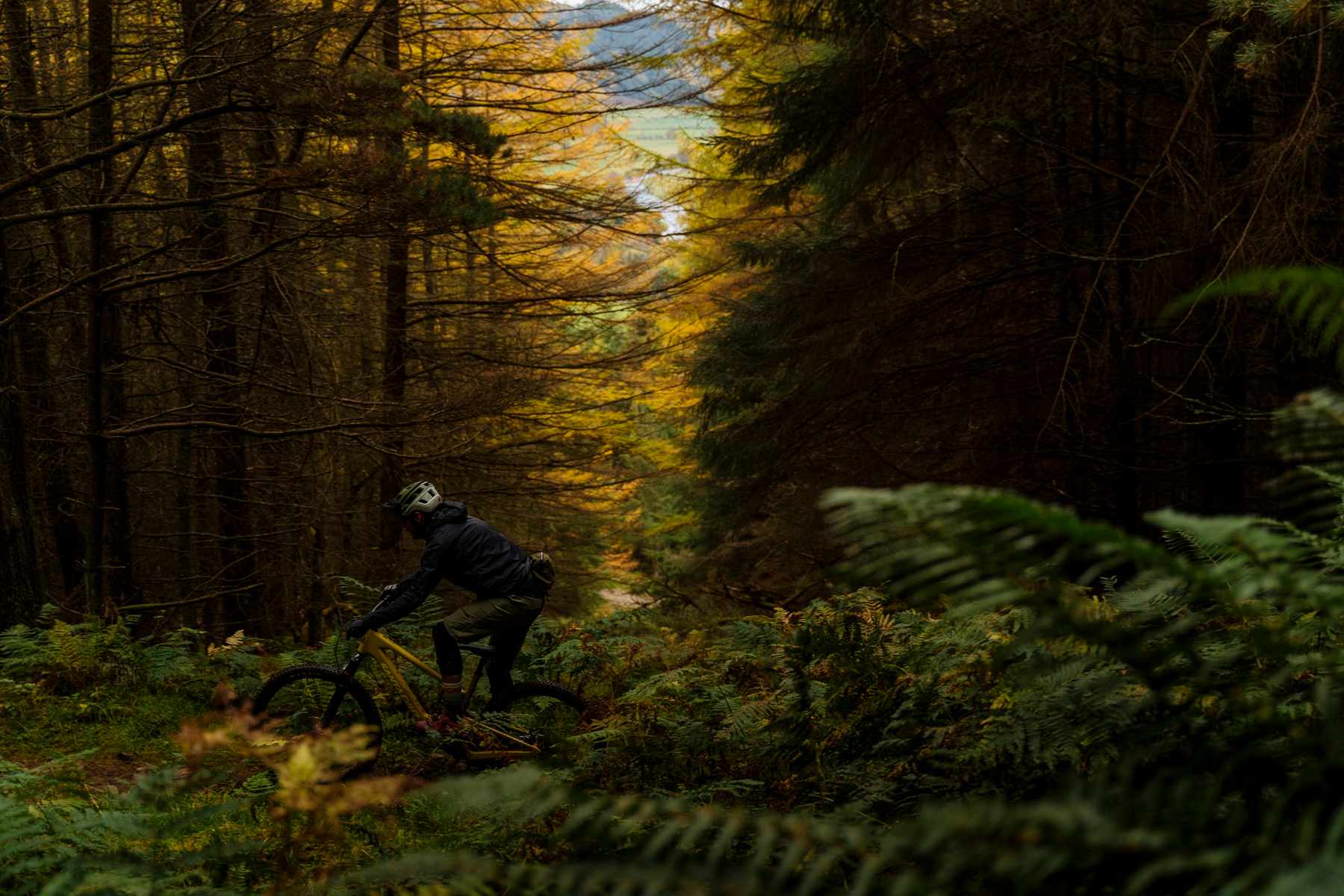
There is a theoretical conflict here as Tweed Valley Guides make money from guiding clients along trails built by others. Once again the reality is a little more complex. There’s been the odd grumble as ‘locals only’ trails have been raced on and left trashed as a result. Some resist the stepping in of a representative organisation and compromises this sometimes means. As a whole though, the vast majority of people I spoke to are simply happy to see so many people enjoying riding in the valley. Sitting in the café, the pub or on the uplift we hear far more ‘have you ridden XYZ yet? It’s awesome’ than holding back. Tweed Valley Guides also donates a proportion of each guiding fee to the TVTA.
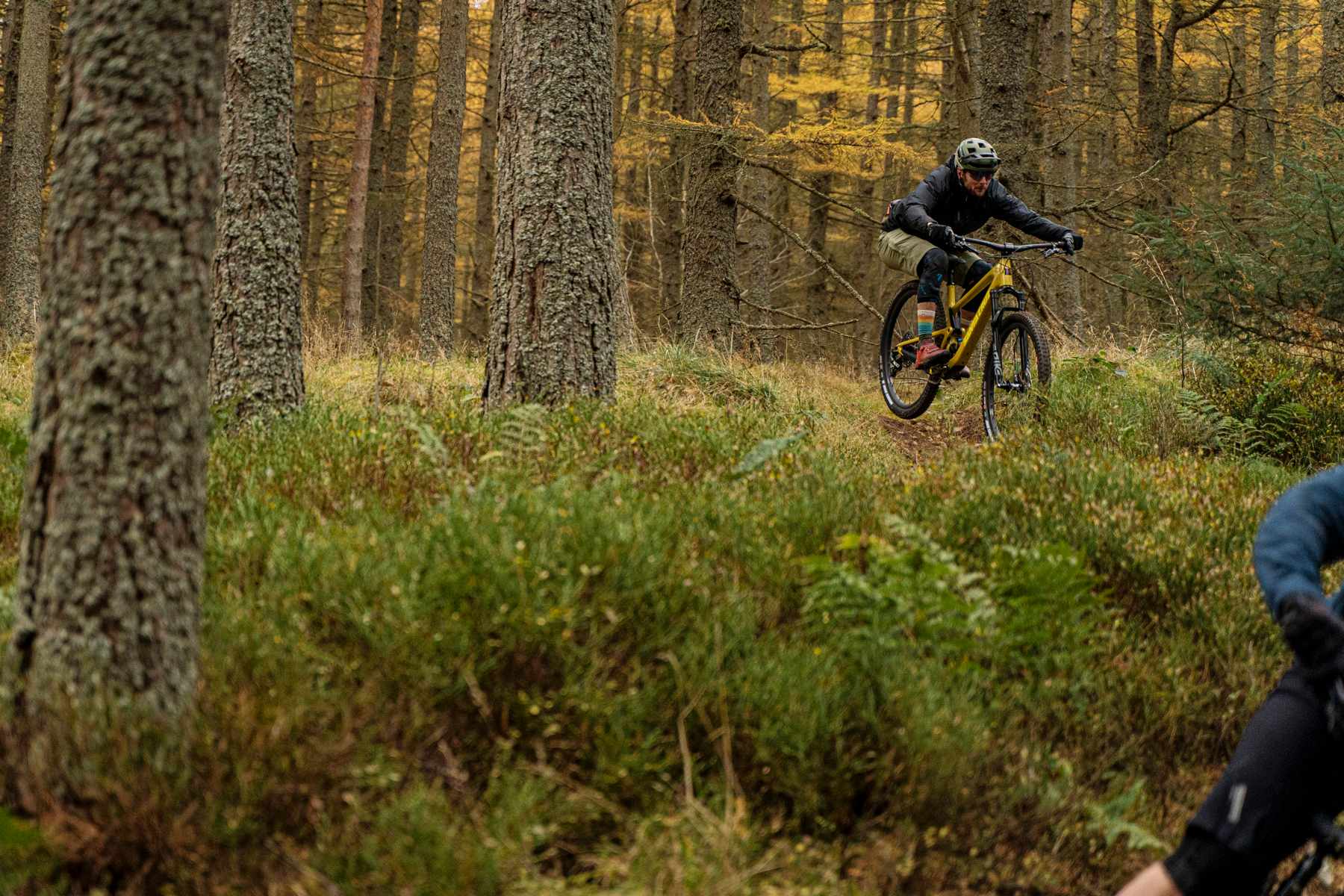
Riding empty – forests
Guiding also has its part to play in promoting the sustainability of mountain biking. It can spread demand away from the trails that are easy to access or find, and a well-informed guide will tailor the route to avoid trails that are susceptible to damage in bad weather (not just to minimise impact, but because they are often not the most fun routes to ride in filthy conditions).
That afternoon we head to Yair Forest – using e-bikes to explore one of the lesser known corners of the Tweed Valley. We link natural-feeling trails with old rights of way, once again not bumping into a single other rider all day. The riding is as good as anything else we’ve done, not least embracing the challenge of climbing the impossible with a bit of e-assist.
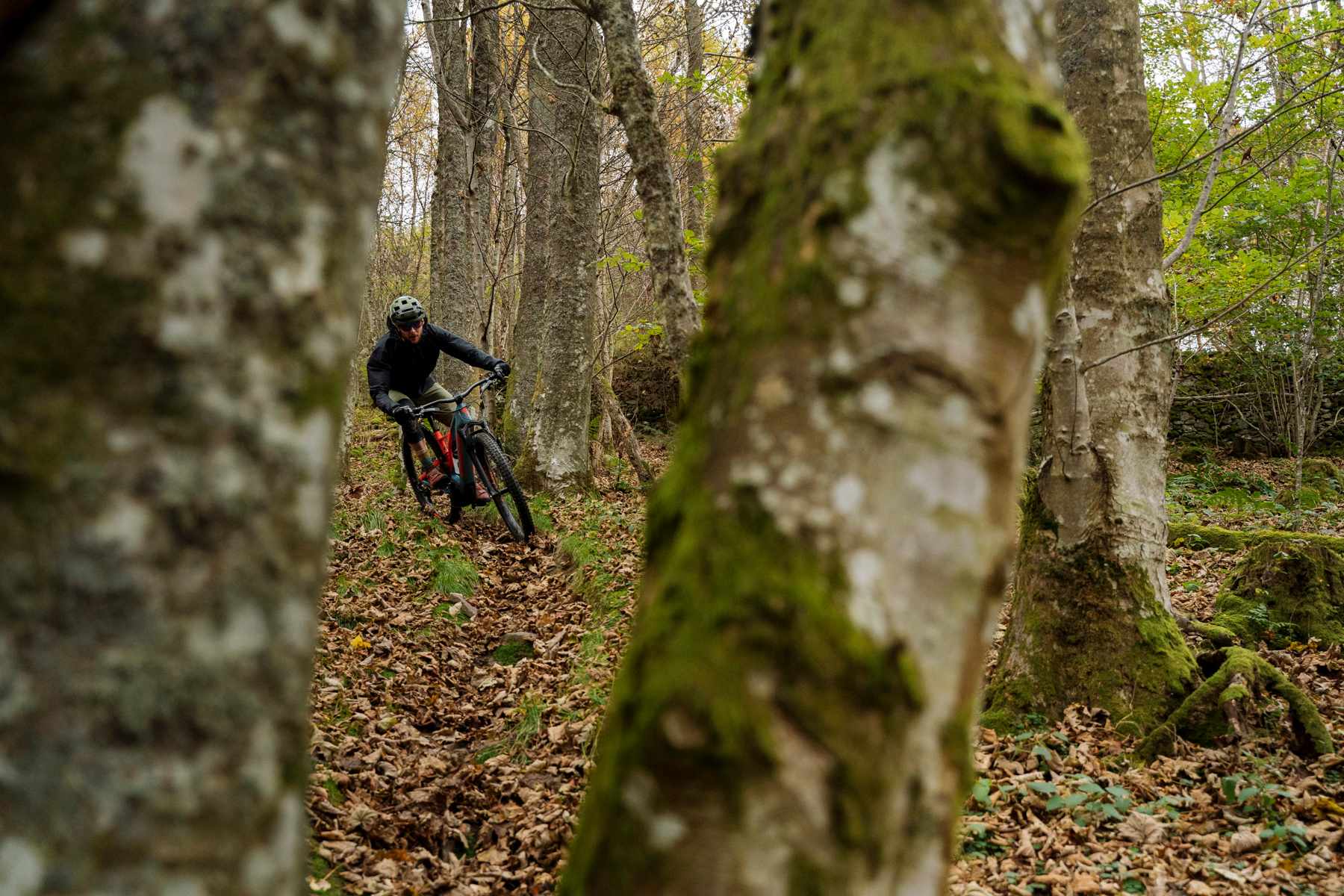
Whether it’s gravel bikes, e-bikes, or enduro and trail bikes that are more capable than the downhill bikes of a decade ago, our riding is evolving. With a bit of creativity, old trails have a new lease of life – from using the main Glentress trail centre climb to gain height on gravel bikes, to descending an old downhill track on a 120mm trail bike.
The day after the ‘official’ visit is over, I join Chris and a couple of mates for another day of riding. We spin along the tarmac cycle path between Glentress and Innerleithen, nudged along by a tailwind. The path is shared with dog walkers and riders using it to avoid the busy A72. We take on a few of the steeper trails in Innerleithen Forest before heading over the road to the Golfie. We bump into a few visitors trying to find a particular trail, relying on memory from a previous visit. As we stop to chat, a heavy rain shower sweeps through and the temperature drops a few degrees. In the end, they follow us down, keen to get into the shelter of the trees. Are they are the kind of riders who might have benefited from guiding? I’d say we all are at some point, for a multitude of reasons.

Guiding UK?
What is clear is that as the Tweed Valley goes through a second mountain biking boom, there is a definite market for sharing the best of what it has to offer, as part of a combined and sustainable approach to attract and keep riders coming back to a truly outstanding area for riding.
There are few places in the UK that are experiencing such a growth in new trails. That doesn’t mean that there isn’t room for guiding elsewhere in the country. There are companies and individuals offering guiding virtually anywhere you can ride a bike. I spoke to a few of them about their customers and the answers were broadly the same. There is no typical customer – it can be someone who is generally a competent rider, but has less experience of navigating themselves, or simply someone wants to make the most of their time in a new area.
Guiding is also fundamental to attracting foreign riders to the UK. Outside of the signposted trail centres, navigating the Highlands or Lake District can feel bewildering to mountain bikers who are used to seeing signposts at junctions, even in the mountains.
Of course, there will always be the rider who gets pleasure out of the planning and navigation of their own routes. The rider for whom the research is as integral to the trip as the pedalling. The rider who doesn’t mind doing a loop ‘the wrong way,’ pushing up technical climbs to descend on tarmac.
For the rest of us, a guide might be part of the toolkit – to be taken out when visiting a new area for the first time, for finding those true locals-only trails, when our imagination has run dry, or we simply want to pass on the responsibility for route finding to someone else for a change.

The heat built up during our climb is quickly whipped away. Jackets zipped up to the chin, we descend quickly down to the valley. One guide leading the way, no stopping at junctions to check that ‘it’s definitely this left, not the next one’. And just as importantly, another guide following, sweeping up those who are flagging and keeping the group together. As we hit the road, we are told the pub is near. I’ve ridden with guides often enough to know that ‘a couple of kilometres down the road’ is a little longer than that, but we are soon enjoying a pint in the warmth while our bikes are loaded into the van. I could get used to this.
Disclosure: The costs of Tom’s trip were covered by Tweed Valley Guides and Visit Scotland.
